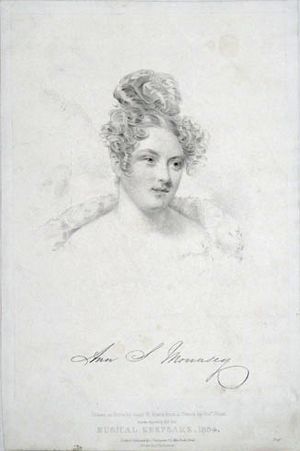Ann Mounsey facts for kids
Ann Mounsey (born April 17, 1811 – died June 24, 1891) was a talented musician from London, England. She was known as a teacher, a conductor, and an organist. Ann also wrote many pieces of music. These included songs, hymns, and music for piano and organ. After she got married, her full name became Ann Mounsey Bartholomew.
Contents
Her Early Life and Learning Music
Ann Mounsey was born in London in 1811. She was the oldest child of Thomas and Mary Mounsey. Her younger sister, Elizabeth Mounsey, also became a professional musician. In 1824, her family moved to Shoreditch, London.
Ann started her music lessons at a famous piano school run by Johann Bernhard Logier. In 1820, a famous composer named Louis Spohr visited the school. He noticed Ann's amazing talent for writing music. Ann also learned to play the organ from two important musicians: Samuel Wesley and Thomas Attwood. Thomas Attwood was the organist at St. Paul's Cathedral in London.
On April 28, 1853, Ann Mounsey married a violinist and writer named William Bartholomew. Ann lived in Shoreditch until she passed away in 1891. She had been unwell for several years and her sister Elizabeth took care of her.
Ann Mounsey's Music Career
As an Accompanist
Ann often played the piano to support other musicians. This is called being an accompanist. One of her most famous performances was in 1845. She played the piano for the very first performance of a large choir piece called Hear My Prayer. This piece was written by the famous composer Felix Mendelssohn.
As a Conductor
From 1843 to 1848, Ann Mounsey organized and led her own public concerts. These were called ""The Crosby Hall Sacred Concerts."" She put on six concerts each year. Ann wanted to share great music with more people in London. She featured music by famous composers like Henry Purcell, Johann Sebastian Bach, Joseph Haydn, and Felix Mendelssohn. She even included her own music! These concerts were very popular and well-liked. People said she did a great job performing the works of the great masters.
As an Organist
Playing the organ in churches was a very important part of Ann Mounsey's music life. In 1828, when she was just 17, she got her first job as a church organist. She worked in different churches in London. Finally, she became the organist at St. Vedast’s Church. She played there for almost 50 years! She retired from this job in 1883.
Special Recognitions
Ann Mounsey received several honors for her musical talents.
- In 1834, she was chosen to be part of the London Philharmonic Society. This was a respected group for musicians.
- In 1839, she became a member of the Royal Society of Musicians.
- In 1840, she helped start a new group called the Society of Female Musicians. This group was for women who were professional musicians.
Ann Mounsey's Compositions
Ann Mounsey wrote a lot of music! Her works included:
- Large pieces for choirs, like an oratorio and cantatas.
- Songs for groups of singers.
- Music for church services.
- About 120 songs for a solo singer with piano.
- Many pieces just for solo piano.
- Music for piano with other instruments.
- Pieces for the organ.


